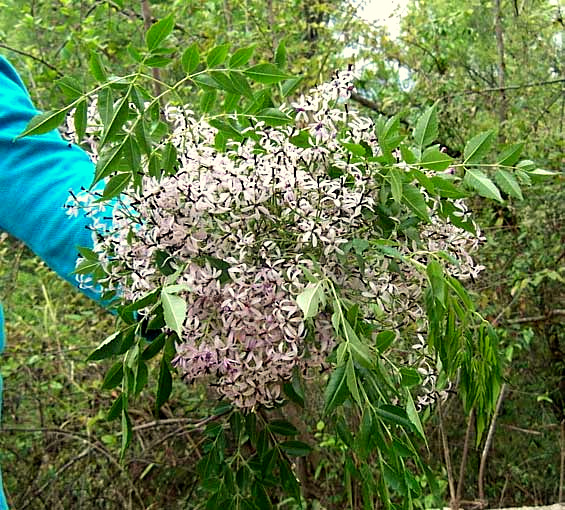Excerpts from Jim Conrad's
Naturalist Newsletter
from the May 5, 2013 Newsletter issued from the Frio Canyon Nature Education Center in northern Uvalde County, southwestern Texas, on the southern border of the Edwards Plateau; elevation ~1750m (~5750 ft); N29.62°, W99.86°; USA
CHINABERRIES IN FLOWER
Chinaberries, Melia azedarach, are invasive trees from Asia now growing wild from coast to coast in the southern US, and as such I should feel resentful that they make it hard on native plants. However, they're pretty trees, and right now in our area they're issuing joyously green herbage mingling harmoniously with big inflorescences of pale purple flowers that smell so heavenly that when I get a whiff of them I feel younger and more naive and romantic than really I ought to, so I just can't not like them.
And just look at how many Pipevine Swallowtail butterflies flit among their flowery branches even on windy days. Below you can see a little corner of the Chinaberry in my backyard, with hot wind from Mexico's vast Chihuahuan Desert gushing up the Dry Frio Valley causing the leaves and flower clusters elegantly and sensibly to yield to the left like any good Chinese Taoist:
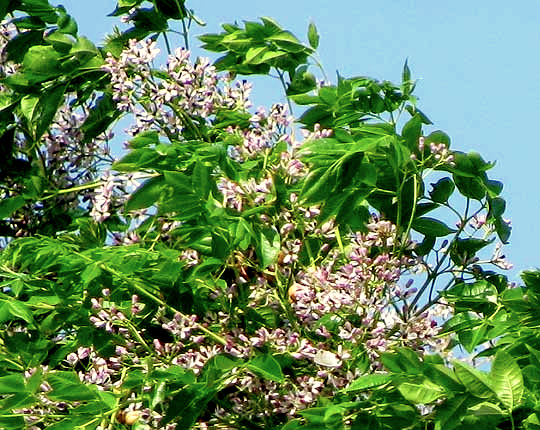
The Chinaberry's larger leaves can be either twice or thrice compound. One is shown below:
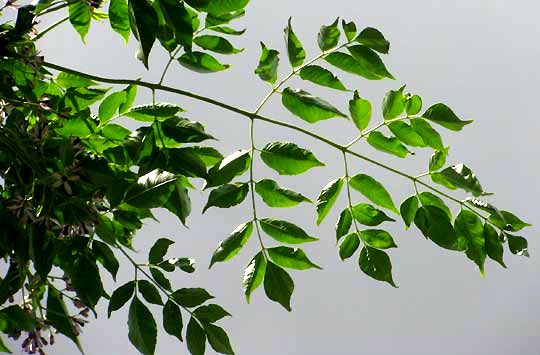
The flowers, if you look closely, display interesting features, as shown below:
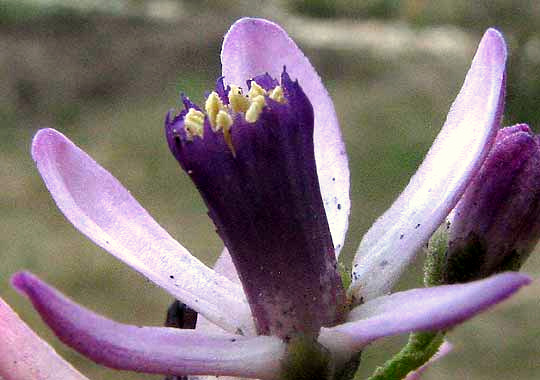
In each flower's center arises a dark purple "crown" a bit like that of a daffodil's. The surprising thing is that the crown is composed of the grown-together stems, or filaments, of the blossom's 10-12 stamens. In the above picture the stamens' cream-colored anthers are seen forming a ring at the crown's mouth, and the filaments themselves -- which usually are slender, stiff, white, matchstick-like affairs -- not only are deep purple and fused together, but produce at their tops pointed, jagged teeth. The filament tube is said to be "lacerate" at the top.
In the Temperate Zone you don't often see this kind of flower structure. However, the filament tube is characteristic of blossoms of the tropical Mahogany Family, the Meliaceae, in which is found not only the Mahogany tree but also the wonderful Spanish-Cedars we saw so many of in the Yucatan.
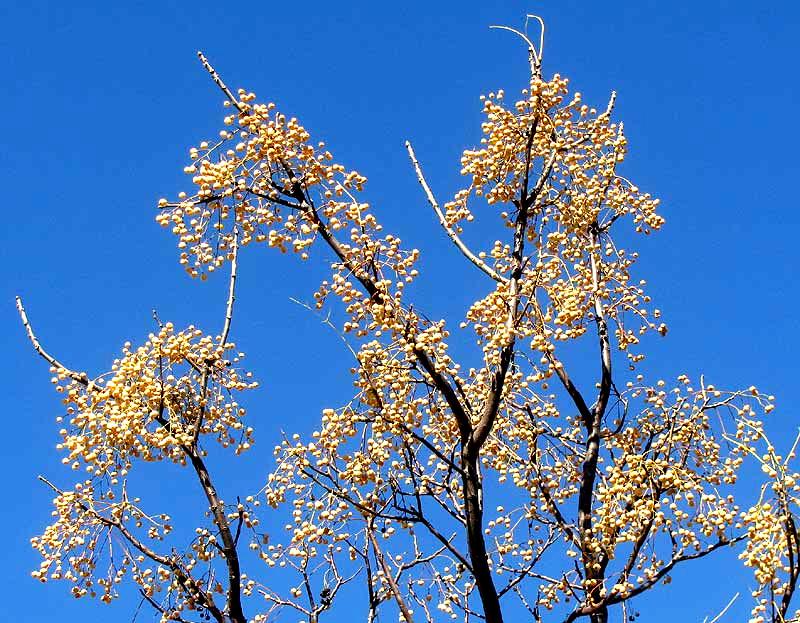
from the December 16, 2012 Newsletter issued from the valley of the Dry Frio River in northern Uvalde County, southwestern Texas, on the southern border of the Edwards Plateau; elevation ~1750m (~5750 ft); N29.62°, W99.86°; USA
CHINABERRIES IN FRUIT
Chinaberry trees, MELIA AZEDARACH, are native to Asia but in North America they were planted as ornamental trees as early as 1830, have escaped and now grow wild from coast to coast in the southern US. Here I don't find Chinaberries growing wild but many people plant them as shade trees that produce masses of pretty, purple flowers and, as they are now, abundant, white, marble-sized fruits. Above you can see that even the branches of leafless Chinaberry trees in fruit are pretty against a blue sky.
I've seen Chinaberry's large panicles of flowers much visited by many pollinators, and also birds eating the fruits, though not with the gusto with which they might go after cherries or even hackberries. You can see a couple of Pine Siskins foraging in the Chinaberry behind the cabin below:
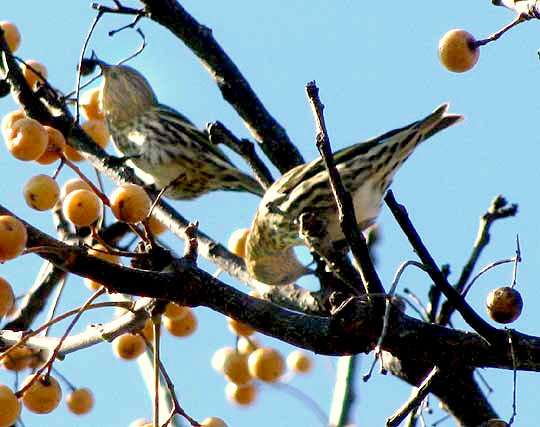
A USDA Forest Service webpage focusing on Chinaberries points to conflicting information in currently available scientific literature about how many seeds occur in each fruit. Therefore, in the service of science I have just stepped outside my door, collected ten fruits from various low-hanging branches and do hereby report that all ten fruits each contained a single hard, stone-like seed. That makes the fruits drupes. Some papers report the fruits bearing up to six seeds, causing the fruits to be berries.
Our fruits, after a hard freeze earlier this week, are turning brown and soft, and smelly, a bit like rancid butter -- the butyric acid smell -- and maybe a little fermented. In fact, reports from Florida say that songbirds may eat so many fermenting Chinaberry fruits that the birds become intoxicated.
from the March 31, 2007 Newsletter issued from Sierra Gorda Biosphere Reserve, QUERÉTARO, MÉXICO
EMELIA'S BOUQUET
Last Sunday I explored dirt roads on the other side of town, going down little valleys and up scrubby slopes, past handsome orchards of orange and guava, and ramshackle, dusty ranchos sometimes not much more than a few cinderblocks topped with rusty corrugated tin sheets and with a hysterical dog tied at a post.
I happened to pass one such rancho just as a señora with two little boys was closing the gate. She held a big bouquet of violet-blossomed Chinaberry flowers, MELIA AZEDARACH, and eyed me suspiciously. After exchanging "Buenos díases" I continued around the bend, saw that the road ended, turned around, and found the señora still standing there, not willing to leave the rancho with a gringo wandering in the neighborhood. When I got even with her again I said that her Chinaberry bouquet was pretty, and asked if she was going to grace her table with it. No, she was going to church, and it was for the Virgin.
I asked Emelia, for that was her name, if I could photograph her pretty bouquet, to show my friends in the north where it was so cold and gray that here in Mexico we had pretty flowers. She hesitated, then handed me a single blossom and said to photograph that, but then she realized that that's not what I wanted, and at the same time I understood that she was embarrassed that she wasn't prettily dressed, wearing a blue sweatshirt so stained that no amount of washing would ever make it look good, and after having two kids she was fat and lumpy. I was sorry that I'd asked, but then I saw her rearranging the leaves so that her bouquet looked better and she stuck out her arm as far from her body as possible and looked away grimacing saying take the picture now, and it's shown below:
